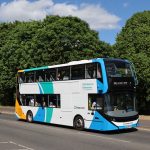Optare’s MetroCity was introduced with a brief to claim a chunk of the market for urban single-deckers. In effect it is a revised Versa, and powered by Daimler’s popular OM 934 engine at Euro 6, although an electric version is available. Tim Deakin drives the diesel demonstrator
Optare builds weight-optimised integral buses across the size range, and in the middle of that spectrum is the MetroCity. With a gross vehicle weight of 12,000kg, it is available at lengths of 10.1m, 10.8m and 11.5m and seating a maximum of 44.
The MetroCity and its twin sister the Versa are built on a common platform, but have a number of cosmetic differences. The Versa is now regarded as a premium product, but the MetroCity is seen as a bread-and-butter city bus, aimed at stop-start work.
At Euro 6, both models are powered by Daimler’s OM 934 engine coupled to a six-speed Allison gearbox, but Optare Engineering Director Alastair Munro has recently confirmed that ongoing development may see other transmission options added in the future (routeone, Manufacturer, 27 January).
Besides the diesel format, the MetroCity and Versa – like all of Optare’s domestic range eventually – are available as electric vehicles (EVs). But while Optare expects demand for EVs to rise in coming years, it accepts that there will also be a long-term requirement for diesel buses.
Its strategy in this regard is simple: Get its buses’ weight as low as possible, optimise their drivelines to the task in hand and keep the whole product as simple as can be.
If all those rules are obeyed, reliability, economic operation and sales success should follow. They apply as much to the MetroCity as to any other member of Optare’s range, and while the Solo is still its best seller, the MetroCity has found its way into a number of fleets.
For an idea of whether it hits the spot or not, Optare kindly made its MetroCity demonstrator available for a routeone First Drive.
The basics
The demonstrator is to the longest length available, 11.5m. Its width is 2.5m, enabling the MetroCity to be sold outside Europe; Optare is seeing success in Australia with the heavier Tempo at the moment, and has also delivered Solos there.
The demonstrator is to provincial specification, and has visited a number of operators around the country. It seats 41, including three tip-ups, and can hold 20 standees; 44 is the absolute maximum number of seated passengers at this length, and is achieved by mounting three seats over the front nearside wheel.
If a wheelchair is carried, seating capacity reduces by three; the buggy and wheelchair area is to the offside, although Optare is able to finish the MetroCity with dual bays.
Upon boarding, immediately obvious is one of its principal strengths: The extent of the low floor area. With a single buggy and wheelchair bay, no fewer than 24 fixed seats plus the three tip-ups can be accessed without reaching a step of any kind, while a solitary position behind the driver is simple to access, albeit on a platform.
Two shallow steps almost between the rear wheels lead to a raised rear section, where 13 seats are located. While the MetroCity does have a rear window – unlike the Solo – it is relatively small compared with its peers’, and is square rather than rectangular. It is also offset slightly.
All seats are high backed and finished in a shade of artificial leather very similar to that used by First Bus in its standard interior specification, although there is no suggestion that this is anything other than coincidental. The ability exists to customise the interior, and things such as charging points and Wi-Fi can be added.
Under the bonnet
The OM 934 engine is shoe-horned into an engine bay that is both compact and full. Despite this, and like all of Optare’s other products, the MetroCity’s power unit, gearbox, cooling system and exhaust – its complete driveline, in other words – are fitted to a cradle that is easily removed once disconnected, making heavy work easy.
Optare goes so far as to say that, regardless of the model, it would be practical to remove the whole driveline unit and replace it with another in the name of getting the bus back on the road rapidly.
Whether that would be of interest to operators in practice can be debated, but it illustrates the ease with which the engine, gearbox or other driveline component can be removed for work to take place.
The demonstrator’s engine is rated at 156bhp and develops 650Nm of torque. It is coupled to an Allison six-speed 2100 series gearbox.
Available optionally is the OM 934 rated at 176bhp and 750Nm, and this may be specified in conjunction with the six-speed Allison T270R transmission.
The latter has a benefit of engaging the lock-up clutch in the five highest gears; the 2100 series does so only in its top four ratios.
When compared fairly, there may thus be a small potential fuel saving to be had with the T270R.
The driver’s view
Optare continues to use its standard cab components on the MetroCity, including the same steering column and stalk arrangement that debuted in the MetroRider over two decades ago. While they remain functional, and the chunky stalks are undoubtedly durable, this is one area where Optare could perhaps update things.
Body functions are controlled by a bank of one-touch buttons to the driver’s right as seen for many years on the Solo, while gear selection and the handbrake are on a ledge below the signalling window.
The EcoDrive dash is fitted to the demonstrator. It consists of a large dial adjacent to the speedometer and a number of more specific performance indicators, such as cornering.
The dial has green, yellow and red sectors, and the needle’s position reflects the driver’s performance. At low speeds it is difficult to keep within the green sector, but once free from traffic, driving economically is easier.
Similarities with other members of Optare’s range continue with the driver’s seat’s position on top of a large moulded unit. While reducing cab storage, it helps prevent the accumulation of debris and rubbish around and under the seat, something that will be welcome.
Cab heating is by blown air, while a handful of fresh air vents are situated around the driver’s legs. Saloon heat and ventilation is controlled by a simple circular dial in the area beneath the ticket machine position, and the MetroCity was comfortably warm during a drive from Sherburn-in-Elmet to Leeds and back.
On the road
Some Optare vehicles have displayed remarkable longevity, with many Solos dating from the late 1990s only removed from service towards the end of 2015 thanks to PSV Accessibility Regulations requirements.
The MetroCity is lightweight like the Solo, but Optare’s use of monocoque construction means that it is inherently strong, and with a robust driveline at Euro 6 it should display similar longevity. It tips the scales at 7,660kg empty.
Driving the demonstrator along some poorly-maintained roads highlighted just the odd rattle from the rear, although these were from a coving panel that Optare’s engineers had removed the previous day to perform work.
Apart from that no rattles or squeaks were to be heard. The Daimler engine is quiet and more refined than its predecessor, the smaller and long-lived OM 904 used up to Euro 5, and engine vibration levels are noticeably lower.
Few drivers will find anything confusing about the MetroCity, and it is doubtful that those already familiar with Optare products would even need type training on it. Controls are clearly marked and easy to use, and – unlike the Versa – there is no perception of a long and potentially vulnerable ‘snout’.
The speed limiter is set to 59mph. If pushed, the bus wastes little time in getting well north of 50mph, although heavy-footed acceleration results in a poor driver performance score.
A full-bore take-off is very rapid indeed, and could be disconcerting to passengers who have not yet found a seat. Combined with a high top speed and six-ratio gearbox this makes the MetroCity as suited to interurban work as it is to stop-start urban duties; many of those sold already are employed on higher-speed services.
The verdict
The name MetroCity suggests a bus that is tilted at the urban, low average speed market. Thanks to an exemplary internal layout it is perfectly suited to that task, but the MetroCity is equally at home outside the city environment where fleet-of-footedness is required.
One of the model’s main strengths is its passenger area. The low floor section is extensive, the window line is deep, and six large opening hoppers ensure adequate ventilation. Bell push provision is also excellent, meaning that the MetroCity ticks every box from a user’s perspective.
Its mechanical aspect should do similar for the operator. Daimler’s engine has proved itself already, and when combined with Optare’s smart charging auxiliaries the manufacturer says that 12mpg is achievable.
There is no reason to disbelieve this claim; sister bus the Versa has cultivated an enviable reputation for fuel efficiency, and some operators have found it to be capable of a similar return without smart charging auxiliaries. Additionally, with the lower-powered Euro 6 engine, the MetroCity is Low Carbon Emission Bus certified, bringing an enhanced BSOG payment.
While the Versa may shade the MetroCity in terms of looks, the latter could just have the edge on practicality thanks to its flatter front.
Both share a common platform and saloon, meaning that there is little between them. They are equally suited to urban and high-speed running, not something that can be said for all buses in the lightweight segment.
Further developments are possible with the MetroCity; Optare does not rule out addition of a Cummins engine at Euro 6, and more gearbox choice could be introduced. It’s a very competent alternative to some of the more well-established models on the market.
























